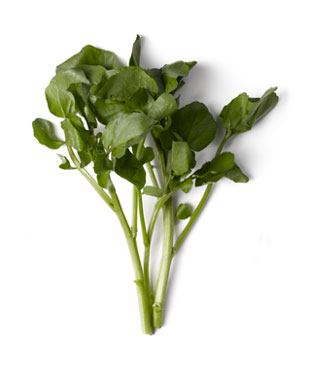Nasturtium nasturtium-aquaticum (nomenclaturally invalid) and Sisymbrium nasturtium-aquaticum L. are synonyms of N. officinale. Nasturtium officinale var microphyllum (Boenn. ex Reich.) Thellung is a synonym of N. microphyllum (ITIS, 2004). These species are also listed in some sources as belonging to the genus Rorippa, although molecular evidence shows that the aquatic species with hollow stems are more closely related to Cardamine than Rorippa.Watercresses are not closely related to the flowers in the genus Tropaeolum (Family Tropaeolaceae), popularly known as "nasturtiums".
Uses
Watercress contains significant amounts of iron, calcium and folic acid, in addition to vitamins A and C. In some regions watercress is regarded as a weed, in other regions as an aquatic vegetable or herb. Watercress crops grown in the presence of animal waste can be a haven for parasites such as the liver fluke Fasciola hepatica]
Many benefits from eating watercress are claimed, such as that it acts as a stimulant, a source of phytochemicals and antioxidants, a diuretic, an expectorant, and a digestive aid It also appears to have cancer-suppressing properties; it is widely believed to help defend against lung cancer.Due to its high iodine content, watercress has a strengthening effect on the thyroid gland, thus beneficial for sufferers of hypothyroidism.
Cultivation
Cultivation of watercress is practical on both a large scale and a garden scale. Being semi-aquatic, watercress is well-suited to hydroponic cultivation, thriving best in water that is slightly alkaline. It is frequently produced around the headwaters of chalk streams. In many local markets, the demand for hydroponically grown watercress exceeds supply. This is due in part to the fact that cress leaves are unsuitable for distribution in dried form and can only be stored for a short period.
However (in the UK at least), the packaging used by supermarkets using sealed plastic bags under some internal pressure (a plastic envelope containing moisture and pressurised (inflated) to prevent crushing of contents) has allowed the distribution of watercress. This has allowed national availability with a once purchased storage life of 1 – 2 days in chilled/refrigerated storage.
Watercress is grown in a number of counties of the UK, most notably Hertfordshire, Hampshire, Wiltshire and Dorset, although the first commercial cultivation was along the River Ebbsfleet in Kent grown by William Bradbery (horticulturist) in 1808. Alresford, near Winchester, is often considered the watercress capital of Britain (to the extent that a steam railway line is named after the famous local crop). In recent years, watercress has become more widely available in the UK, at least in the South-East, being stocked pre-packed in some supermarkets, as well as fresh by the bunch at farmers' markets and greengrocers. Value-added produce such as the traditional watercress soup, as well as watercress pesto are increasingly easy to source.
![]() Copyright(C) 2007
- 2020. All rights reserved.
Copyright(C) 2007
- 2020. All rights reserved.
